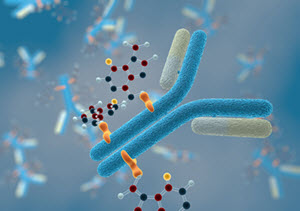 Are you tasked with the bioanalysis of antibody drug conjugates (ADCs)? If so, you know they represent a rapidly growing class of biotherapeutics, but their unique chemical structure makes quantitative analysis particularly challenging.
Are you tasked with the bioanalysis of antibody drug conjugates (ADCs)? If so, you know they represent a rapidly growing class of biotherapeutics, but their unique chemical structure makes quantitative analysis particularly challenging.
So, what is the best technique to create a novel quantitative analysis solution that accelerates method development and improves the performance of ADC pharmacokinetic assays?
Typically used Ligand binding assays (LBA) such as Enzyme-Linked Immunosorbent Assays (ELISA) have many advantages. However, LBAs can suffer from high variability, limited dynamic range, and problems with selectivity. An alternative comes with liquid chromatography-tandem mass spectrometry (LC-MS/MS), which has found widespread use in the quantitative analysis of small molecule drugs. While LC-MS/MS assays are exceedingly selective, with excellent dynamic range and reproducibility, they can lack sensitivity when applied to protein therapeutics.
In search of a solution, our experts developed a unique workflow with outstanding results. We combined a universal immunocapture enrichment strategy with sample preparation and a hybrid LBA microflow LC-MS/MS technique and applied it to the total antibody analysis of the ADC of Ado-trastuzumab emtansine in plasma.Read the full report in Chromatography Today >
Some of the highlights:
- High capacity magnetic immunocapture beads coated with streptavidin and reagents from the SCIEX BioBA Sample Prep Kit accelerate method development for total antibody enrichment. The beads offer several advantages including ease of handling, scalability, improved sample recovery and parallel sample processing.
- The use of microflow LC provides far superior sensitivity compared to traditional flow LC, enabling up to 5x lower LLOQ. Microflow LC is ideal for applications where you need quantification at low concentrations and/or where sample volumes are limited.
- The SCIEX QTRAP® 6500+ with IonDrive™ Turbo V Source was used with a technique called multiple reaction monitoring (MRM). In MRM, the precursor ion of a specific analyte is selected in the first mass analyzer, fragmented in a collision cell and then one or more of the resulting product ions are monitored in the second mass analyzer. This provides an exceptionally selective and sensitive method for quantification.
- Transitions and MS parameters were optimized using DiscoveryQuant™ software and kept constant for both experiments. Our MultiQuant™ 3.0.2 software performed data analysis.
This hybrid LBA microflow LC-MS/MS workflow using high capacity streptavidin coated magnetic beads provides a customizable immunocapture strategy that enables the rapid development of high sensitivity pharmacokinetic assays of biotherapeutics during pre-clinical or phase HC studies.
The workflow applies to mAB based therapeutics and results in faster assay development with wide dynamic range, high selectivity, and high sensitivity, with a lower LLOQs than typically achieved by LC-MS/MS using a direct plasma or pellet digest.
Find out how our BioBA Solution can accelerate your biologics bioanalysis >






 Contact Support
Contact Support
0 Comments